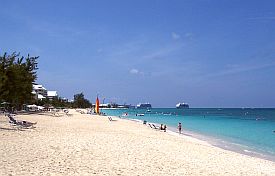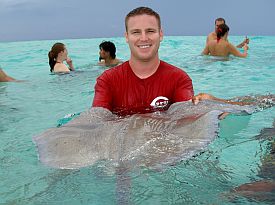
is a lush, tropical paradise of many islands with world-class beaches, snorkeling and scuba diving, golf courses, and more. Each year, 30 million tourists visit its 7,000 islands making up 28 separate countries. I got to spend three days in Grand Cayman, one of the three islands that make up the Cayman Islands, a British Overseas Territory with a population of 60,000. The Cayman Islands have no income or business taxes and are famous as
tax havens where wealthy individuals and corporations can hide large amounts of money to get out of paying taxes in their home countries. With the lack of tax
With the lack of tax income, the country relies on import duty fees, approximately 20 to 25 percent, as well as an airport departure tax similar to what we have in the Philippines. Tourism accounts for nearly 70 percent of the islands’ economy.My main reason for wanting to visit Grand Cayman is its world-class beaches, including the popular Seven Mile Beach. Maybe the tourism marketing team got a little carried away, but the actual length is around six miles of pristine, white sand. The beach is as stunning as any I have visited in the world; what sets it apart is a law declaring all beaches public property. While hotels and resorts can be found
My main reason for wanting to visit Grand Cayman is its world-class beaches, including the popular Seven Mile Beach. Maybe the tourism marketing team got a little carried away, but the actual length is around six miles of pristine, white sand. The beach is as stunning as any I have visited in the world; what sets it apart is a law declaring all beaches public property. While hotels and resorts can be found all along the beachfront, the entire six-mile stretch is open to the public. The surrounding coastline is well-known for snorkeling and scuba diving, as there are shipwrecks nearby that draw enthusiasts from across the globe.
While it was the beaches that drew me to this island paradise, it was the wildlife that was the true highlight. From Seven Mile Beach, we headed north to West Bay and the Cayman Turtle Center. The center opened in 1968 to save the endangered Green Sea Turtle. The drop in population was caused
by the destruction of their natural habitat, and hunting as turtle meat has been a part of the local diet as long as there have been people living on the Cayman Islands. Some turtles are also raised there for the meat, as they believe if they make it easily available, it will reduce the illegal hunting of wild turtles. As we walked through the facility, we saw each stage from the tiny baby hatchlings splashing about in water up to fully-grown turtles that weigh as much as 200kg. We passed by
Some turtles are also raised there for the meat, as they believe if they make it easily available, it will reduce the illegal hunting of wild turtles. As we walked through the facility, we saw each stage from the tiny baby hatchlings splashing about in water up to fully-grown turtles that weigh as much as 200kg. We passed bya pool of medium-sized turtles when our guide picked one up and let us hold it. They’re a little slimy and difficult to hold as they wiggled about, but it was enjoyable nonetheless. Since the opening of the center, they have raised and released over 30,000 green sea turtles into the sea.
They remain on the endangered list but progress has been made.
The center has become a tourist attraction that has raised both awareness and money from the entrance fees. At the end of the tour is a gift shop and cafe; upon the urging of the guide, I tried the local delicacy of a turtle meat sandwich. Sadly the taste is not so exciting, falling somewhere
between chicken and fish. At least, I can say that I tried it.
The following day, we traveled by bus through the countryside from the capital of Georgetown to the eastern part of the island and the Blue Iguana Nature Reserve. The blue iguana, a native lizard that can only be found on the island of Grand Cayman, is one of the longest-living species of lizard. It got its name from its blue-tinted skin, and as the largest land animal on the island, they can grow up to 5 feet long and weigh up to 14kg. I was advised to go early as the iguanas are cold blooded and most active in cooler morning temperatures. During the hot
During the hot afternoon, visitors can mostly see them sit still and cool off in the shade. In 2003, they estimated the wild population to be virtually
extinct. The reserve opened and like the turtles, they began raising them from eggs until adults and released them into the wild. Throughout our visit, we saw baby iguanas in cages up to full-sized adults allowed to openly roam sections of the 88-acre reserve.
To date, they have raised and released over 700 blue iguanas into the wild. Our guide explained that the long-term success looks encouraging, as they have found hatched eggs in the wild from released iguanas. On our way to the adjacent botanical gardens, the guide went in front, carrying a large stick to scare off any potential incoming iguanas.
On my last full day, I put all fears aside and decided to meet face-to-face with one more native animal: the stingray. There is a sandbar located a 45-minute boat ride away where fishermen used to dump scraps overboard. The stingrays would hear the sound of the boats approaching and gather knowing there was a meal to be had. Today, the boats contain tourists instead of fishermen, but the guides bring food to continue the instinctive behavior. As we climbed out of the boat, we were able to swim with the stingrays, feed them pieces of squid, and at one point, hold one if we dared. While feeding, we were told to not extend our fingers, as they will try to eat them along with the food. Luckily, they suck in their food
While feeding, we were told to not extend our fingers, as they will try to eat them along with the food. Luckily, they suck in their foodinstead of biting, so the worst wound in the group was a slight nick of a finger. It is considered good luck to kiss a stingray, and I couldn’t pass up that photo op.
But with all the excitement, the encounter is not without risk as the stingrays have a poisonous barb on their tail. We were instructed to shuffle our feet instead of picking them up to avoid any barbs. This once in a lifetime experience draws nearly 1,500 tourists every day. However it’s not without controversy. As with the whale shark experience in Oslob, there is debate on the impact of the tourism and its long-term consequences to the species.
As my trip drew to a close, I realized how different it went than planned, but that made it memorable. My original goal was to relax and do nothing but
sit on the beach. But with local recommendations, it turned into an incredible experience. It was a reminder that while traveling, plans are good, but sometimes it’s best to keep an open mind and go with the flow.

